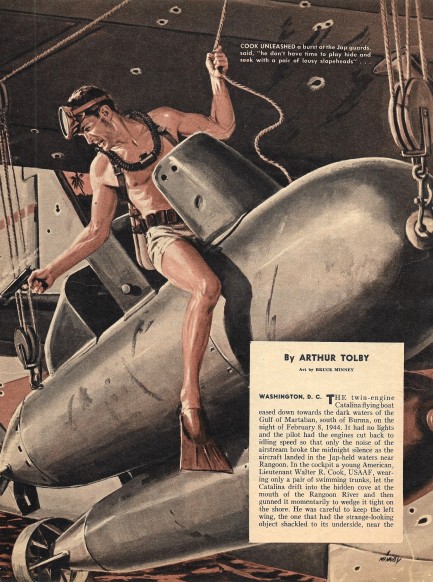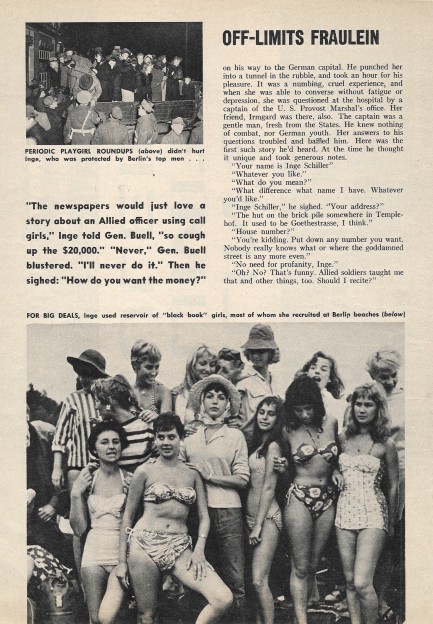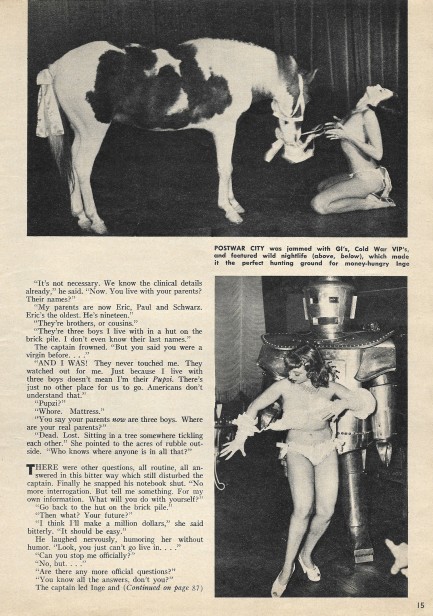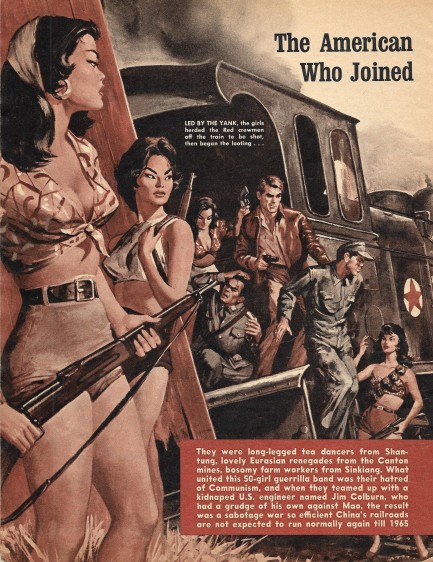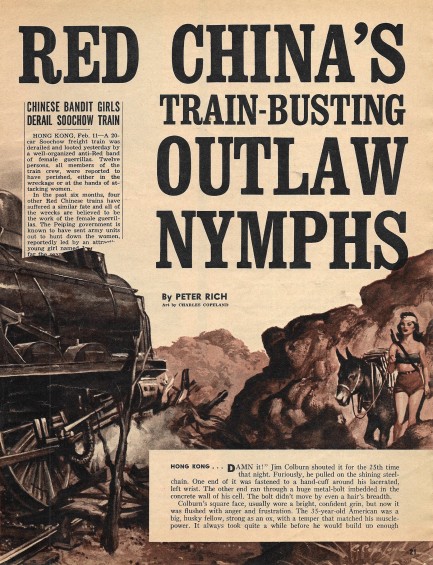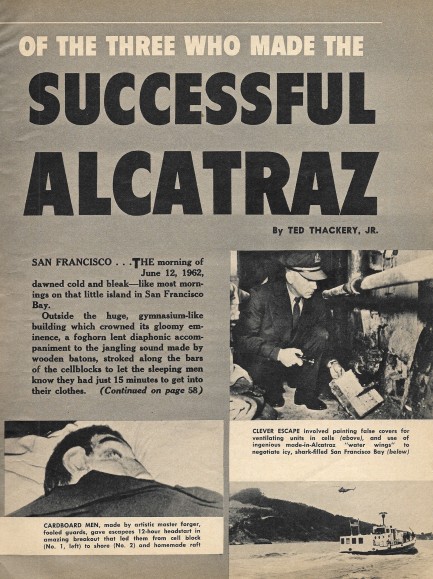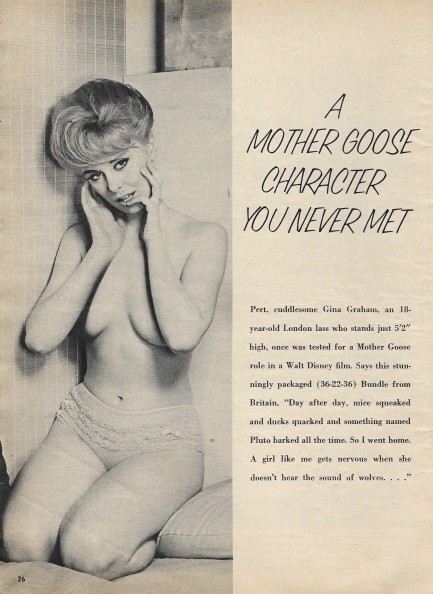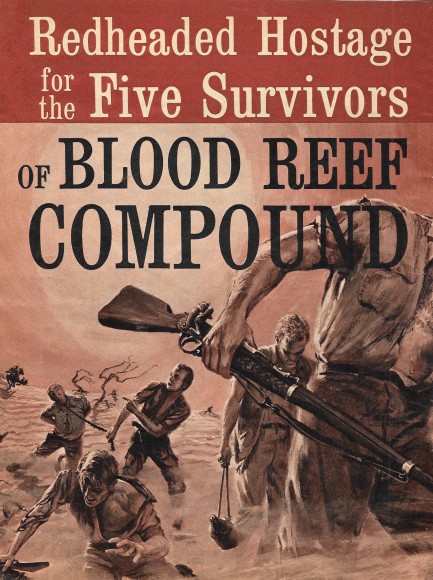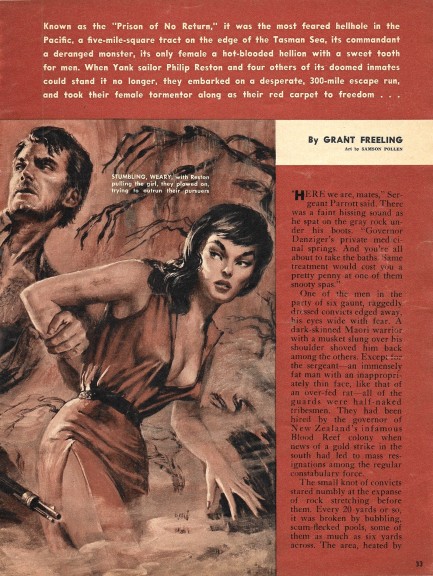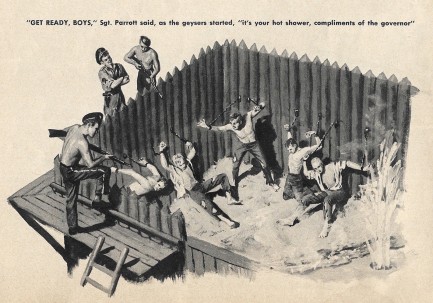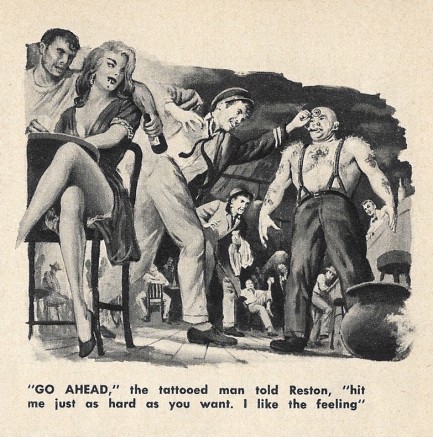 Powell shoots for a comedic mystery but doesn't have Hammett's perfect aim. 
What is a "hilarious all-action thriller" like? That's the question that went through our minds when we impulsively ordered Richard Powell's 1946 novel All Over but the Shooting, though we were also drawn by the cover. The book was originally published by Popular Library, but the striking version you see above with art that's unfortunately uncredited came from the British imprint Hodder & Stoughton in 1952. Powell weaves a tale set in 1942 about Richard Blake and his danger-magnet wife Arabella—Arab for short—who believes she's stumbled across a spy plot centered around a Washington, D.C. women's boarding house. Determined to delve for answers—and to her husband's chagrin—she pretends to be a single woman, takes a room, and starts poking around. Her suspicions are of course correct. The place is a den of Nazis.
Powell thinks outside the box about every aspect of his story: how the conspiracy is uncovered, how the investigation proceeds, what clues are found, and what leaps of intuition keep the intrepid Arabella moving toward a solution. But the entire story is preposterous. Example: when Arab seems likely to be connected to a raincoat she lost while fleeing for her life, her hubby manages to sneak into the room where it's being kept—while its occupant is just upstairs—and have it altered in five minutes by a conveniently situated maid. That way the coat won't fit Arab when the villain tries to say it's hers.
That and about two dozen other moments are silly. Powell achieved, we think, exactly what he set out to do as an author, but we didn't find the book to be exactly scintillating. It was no Thin Man, for example, Dashiell Hammett's smashingly successful amalgam of humor and danger. But in the same way Arab erodes her husband's disbelief and finally gets him to buy into her wacky ideas, she wore us down too. She's a fun character, and makes the book worth a read. We won't seek out Powell again, but one spin around wartime D.C.? Sure, okay.

 Toto we’re not in Africa anymore. 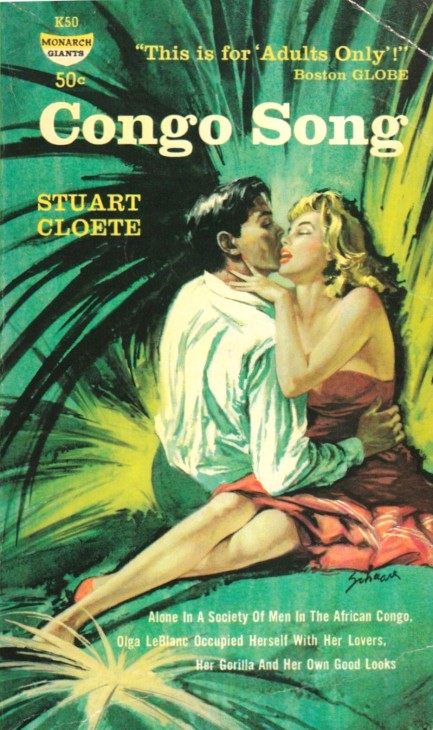
We said we'd get back to Stuart Cloete’s 1943 jungle drama Congo Song, and here we are. The book has been reprinted often, including in the 1958 Monarch edition you see above, with Harry Schaare cover art. Its popularity certainly owed something to the fact that it was another book that nurtured popular Western stereotypes about life in Africa, including that it attracted decadent and damaged whites whose weaknesses were inevitably amplified by the deep, dark, primitive, savage, mysterious continent. You've read something like this once or twice, we bet, thanks to Hemingway and others, though Cloete, who was from South Africa, writes in an entirely different style than Papa:
This was the Congo song: the song of sluggish rivers, of the mountains, the forests; the song of the distant, throbbing drums, of the ripe fruits falling, of the mosquitoes humming in the scented dusk; the song of Entobo, of the gorilla, and the snake. The song no white man would ever sing. The wild dogs cry out in the night as they grow restless, longing for some solitary company. Oops—that last sentence is from the Toto song “Africa.” Don't know how that slipped in there. Anyway, Congo Song unfolds in the months before the start of World War II. Cloete’s characters are diverse, with his main creation being Olga le Blanc, the only woman living in an isolated outpost called Botanical Station with several men, including her husband, a researcher who spends a lot of time away. Olga is a vamp who must make other men fall in with love her, and her affections don't end at homo sapiens sapiens—she has a gorilla, unsubtly named Congo, that she nursed at her own breast when it was an infant. Cloete’s symbolism is pretty thick milk. Erudite conversation, circular philosophizing, seductions, and secrets abound at Botanical Station. One of the other main characters is an American named Henry Wilson who has been sent by handlers in Nairobi to keep an eye on the doings of a German spy named Fritz von Brandt. Olga, meanwhile, spies on von Brandt for the English—sometimes from his bed. Other characters have less purpose, and many eccentricities. One drinks too much. Another sleeps with teenaged Congolese girls under the guise of employing them as domestics. The researcher seems to love trees more than Olga. Nobody is particularly happy. Who is who? Who wants what? There's another spy, who we won't name, a machine-like man, asexual, immune even to Olga: Women were the weakness of so many. Money, luxury, power, all resolved themselves finally into women. That was where the money went. That was what the power was used to obtain. How lucky he was to have been born without sexual feelings. All the duplicity in Congo Song derives from the looming war in Europe, but there's also another driver: “Under all this,” Olga observes, “is the never-ending fight for the riches of Africa.”
Despite all the dinners, safaris, subterfuges, and soliloquies—or maybe because of the soliloquies—the book doesn't gather momentum until about page two-fifty, after a fatal accident. Then things move fast enough to cause whiplash. Death comes by various methods, none of them banal. And of course there's still that gorilla. He lives in the house with the le Blancs, but Olga lets him loose regularly. Surely that'll end with limbs separated from bodies and blood on the louvered doors. And Cloete clearly must—absolutely must—squeeze in a little lethal witch-doctoring. No more plot hints. However, it isn't a spoiler to reveal that since Cloete follows the basic blueprint of other books of this type, at least a character or two eventually flee for modern civilization. But they'll remember Congo with bittersweet nostalgia—primarily during a maudlin denouement drawn out over several chapters. But it's understandable—it's not easy to let go of such beauty and horror. Not easy to let go of Congo Song either. It wasn't perfect, but it was very interesting. It’s gonna take a lot to take me awaaaay from yoooou… There’s nothing that a hundred men or moooore could ever doooo… I bless the rains down in Aaaafricaaa… 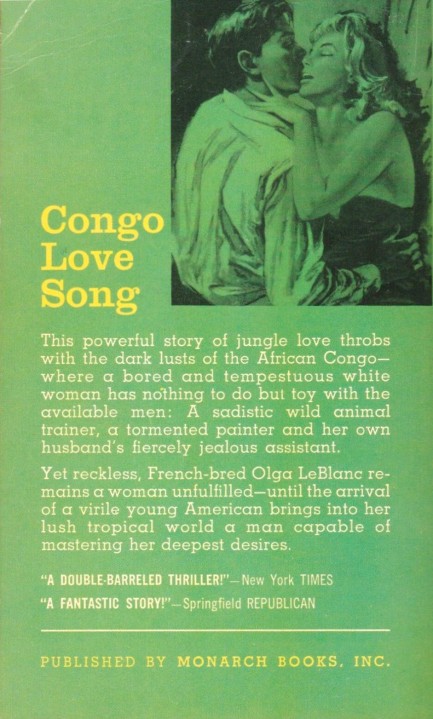
 It's not comfortable, but it's reliable. 
We're back to men's adventure mags today with an issue of Male from this month in 1962, with cover art by Mort Kunstler illustrating the tale, “The Hell-Raising Yank and His Remarkable Flying Sub.” We gave the story a read and it tells of Walter R. Cook, a U.S. soldier stranded in Burma who, with the aid of a local beauty (of course), finds and refurbishes an abandoned Catalina seaplane, which has attached to it a two man submarine. The sub was a type used during World War II that the operators rode like horses while breathing through scuba gear. Cook uses it to disrupt Japanese supply lines.
The story is a standard sort for an adventure magazine, but educational, since we'd never heard of rideable submarines. The illustration makes clear exactly what form it took. The magazine also offers stories set in China and New Zealand, and contains a detailed piece on an escape from Alcatraz, the very escape that inspired the Clint Eastwood film Escape from Alcatraz, involving the inmate Frank Morris, who may or may not have actually succeeded. The art throughout the issue is from the usual suspects—Charles Copeland, Samson Pollen, and Bruce Minney—and is tops as always. We have seventeen scans below.
 Every flight was a one-way trip. 
Above is a photo of a Word War II era Yokosuka MXY-7 Ohka, or “cherry blossom”—not a legit airplane, but rather a barely aerodynamic, wooden-winged, jet propelled craft released from on high and meant to be steered into enemy ships, whereupon the massive bomb that made up the nose of the ungainly contraption would detonate. Piloting one was considered a great honor, though few hit their targets due to their fragility and lack of maneuverability. These were dubbed by American servicemen “flying coffins,” for obvious reasons. This example was captured on Okinawa, which is why you see a “keep out” sign and a U.S. military policeman standing guard. The photo, which is one of the better ones we've seen, was published today in 1945.
 The only way to survive is by rationing. I've come up with a plan. First we'll eat him, then I'll eat you. 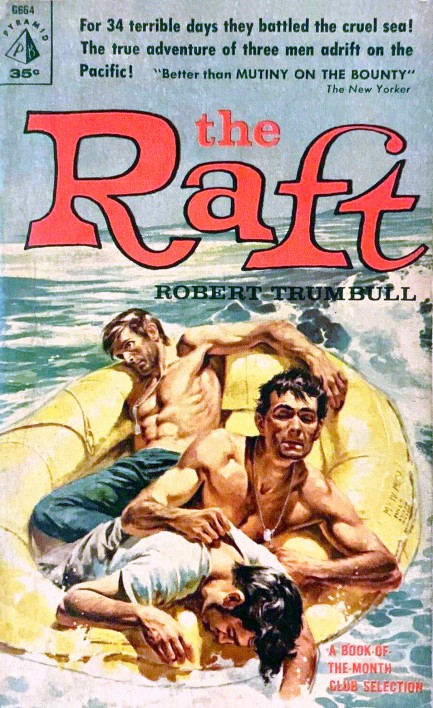
Well, our three castaways—Harold Dixon, Gene Aldrich, and Tony Pastula—are still floating on the high seas, and the situation has gone from bad to worse. They'll get out of this dilemma yet, though. Only a minor spoiler there, since The Raft—which details thirty-four days spent stranded at sea by three downed flyers—is a World War II biography, not a novel, and the tale is well known. But if you're unfamiliar with it, what you get is hot days, cold nights, constant soakings, several capsizings, a loss of gear, food, and hope, and an extraordinary—by which mean stranger than fiction—ending. This particular copy looks like it spent thirty-four days at sea too, but it's the best we could find.
 Sugawara gives the red light to wartime slavery. 
This blazingly colorful promo poster was made for the action movie Onna dorei-sen, known in English as Female Slave Ship, which is set during World War II and follows the adventures of a navy lieutenant played by Bunta Sugawara. The tale begins with him sent on a secret mission to obtain radar schematics to help salvage Japan's waning war fortunes, but unfortunately his plane is shot full of holes by a squadron of American F4Fs and he ends up in the drink. He's picked up by a Shanghai bound China boat, or slave ship, carrying twelve women meant to be auctioned to a gathering of Epsteins. Eleven of the women are prostitutes, but Rumiko, played by the lovely Utako Mitsuya, was tricked onto the boat. Naturally, she and Sugawara form an instant connection. Can he save her? You can be sure he'll try his best.
But just when you think Female Slave Ship is a straightforward white-knight-saves-damsel tale, the slave ship is attacked by pirates, and the women and Sugawara are suddenly at the mercy of the most ruthless band of unbathed thugs ever to steam the East China Sea. After some onboard drama the vessel lands, not in Shanghai but on a rocky Chinese coast where traffickers plan to brand and sell the women. This obviously can't stand, which means Buntawara must somehow throw sand in the gears. Why he's even alive at this point is a question. He's been nothing but trouble to the pirates, and the simplest solution would have been to toss him to the sharks. Failing to do that will be a costly and contusion making error.
We wanted to get away from Nikkatsu Studios' misogynistic roman pornos for a while and this effort from Shintoho Film fulfilled the requirement. Well, mostly. While generally tame, you'll rarely see so many women slapped around. But the treatment is meant to outrage. Mission accomplished. You will hate these traffickers. As for the movie overall, we suspect you'll like-not-love it. It's done in broad strokes, but as a sort of surf-to-turf soap opera it mostly works fine. Sugawara, who was soon to become a cinematic icon, has a charisma befitting his burgeoning status. And Yôko Mihara, already a big star at this point, is enjoyable playing a slippery slaver whose allegiances shift with the tides. She and Sugawara are worth seeing. Female Slave Ship premiered in Japan today in 1960.
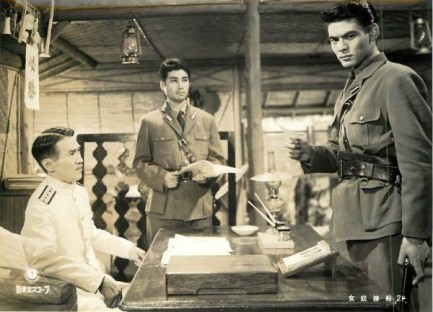 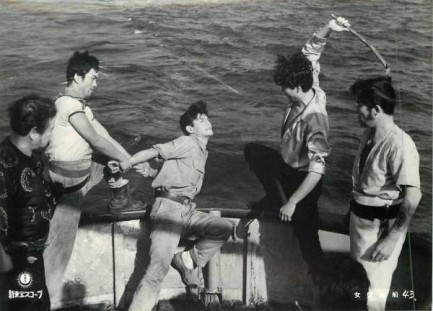  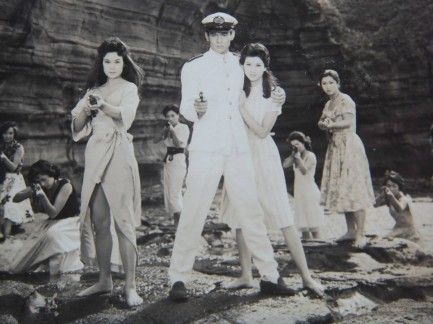 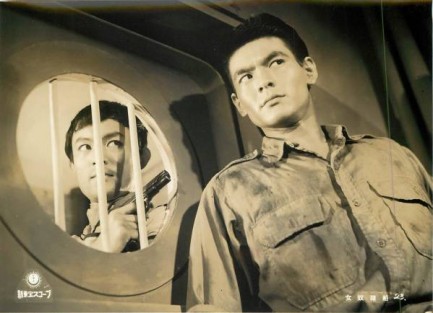  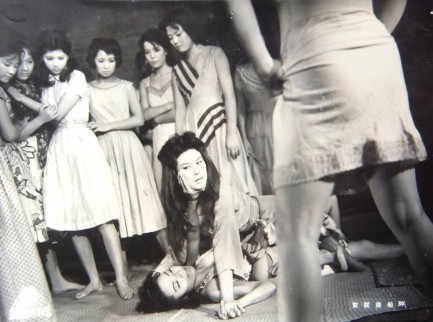
 Thanks for rescuing me. Don't untie me yet, though. First let me tell you about this kinky fantasy I've always had. 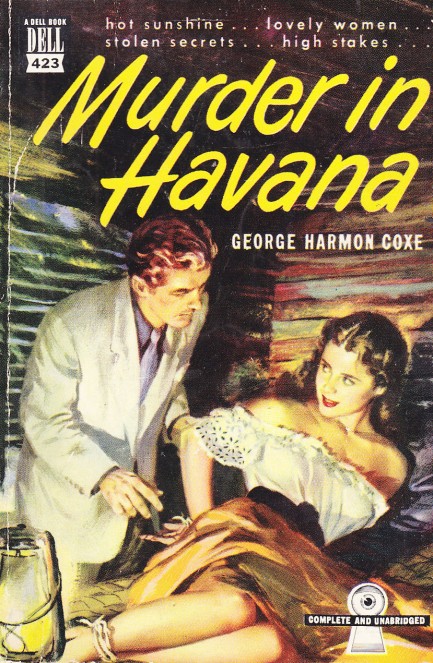
George Harmon Coxe's Murder in Havana was an easy buy for us—it was cheap and set in an exotic land. We were also drawn by its World War II backdrop, which made us fully expect Nazis, and we got them. The story concerns Andrew Talbot, who's in charge of a secret shipbuilding project. While he's out on the town someone breaks into his hotel room but somehow ends up dead five floors below. Talbot is relieved not to have been robbed of his top secret dox, but once he realizes the dead man hadn't been the only person in his room and his papers were photographed rather than stolen, he sets out to save his professional reputation and unmask the spies. As required from this sort of tale, the hero meets a couple of beautiful women, interfaces fractiously with the local cops, gets knocked over the head, and drinks rum. Mysteries from this era can be wordy, but Coxe deserves credit—he keeps the action moving around Havana and avoids the pointless reiterations that can slow these books. The ending is fun, and multi-layered. There could be more local color and travelogue, and we aren't sure if we accept the idea of skeleton keys being purchaseable on the street, but overall Murder in Havana is quite entertaining. It was published in 1943 originally, with this Dell edition and its Barye Phillips cover art of a woman bound but incongruously smiling coming in 1950.
 Everything is working perfectly—for the killer. 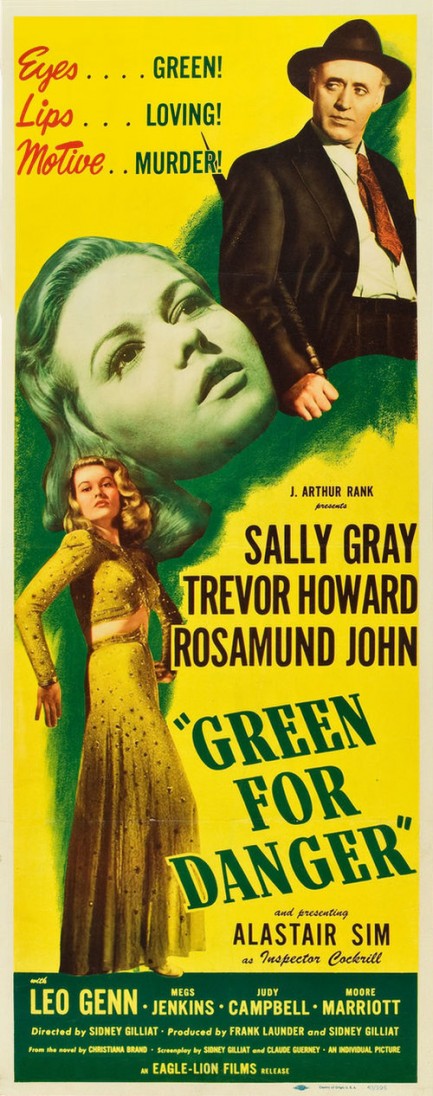
Above is a beautiful alternate poster in the elongated style known as a three-sheet for the thriller Green for Danger, which we talked about last year. We love this piece. The movie deals with medical mishaps—or is it murder?—in a London hospital during World War II, and stars Alistair Sim, Trevor Howard, Sally Gray, and Rosamund John. It premiered in England today in 1946. You can read more here.
 In New York City people of a certain class live on the Upper East Side. Stockbrokers, lawyers, Nazis... 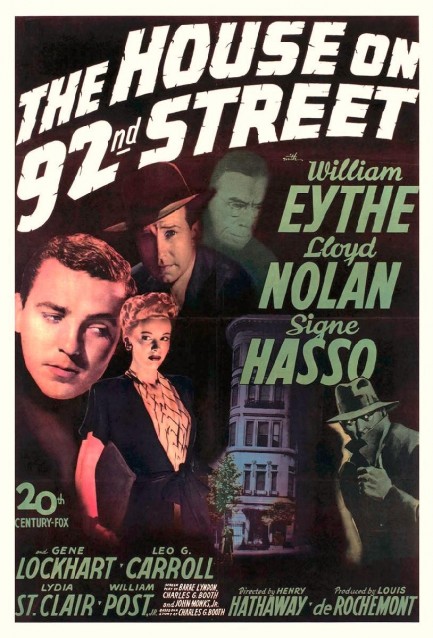
This poster would have sucked us right through the moviehouse doors had we been around when it was on display. It has beautiful colors, an air of mystery, a nice design, and dramatic graphics. The House on 92nd Street, which starred William Eythe, Lloyd Nolan, and Signe Hasso (who we've seen a lot of lately), definitely doesn't rise to the level of the promo art. It qualifies as a propaganda film, though the events depicted are accurate. But with J. Edgar Hoover appearing briefly in the prologue, a stentorian narration, stilted dialogue, and a soundtrack that veers toward the martial, it's pretty hard to immerse yourself in what is undeniably a Hollywood-on-FBI stroke job.
If you take the plunge, the movie turns out to be about a German American student who is recruited by Nazis but instead becomes a double agent for the FBI during the period when World War II was raging in Europe but the U.S. wasn't militarily involved yet. German spies had been deployed around the U.S., and the movie deals with a particular group that gets wind of an important military secret, the secret of—dum dum duuuuuuum—the bomb. You know. The big bomb. The A-bomb. The nuke. The edge. The be-all. The end-all. The mushroom cloud layin', eyeball meltin', city flattenin', effervescently fissionatin' ordnance both Germany and the U.S. thought would win the war. Good premise, actually.
But since World War II was almost over when the film came out, the plot's outcome was a given. Did audiences feel any suspense? We aren't convinced. Even if the FBI hadn't routed out the spies, the skyrocketing Upper East Side real estate prices would have. The Nazis would have moved to the Bronx seeking cheaper rent. With the conclusion not in doubt, the movie's thrills needed to be provided by the audience's attachment to double agent Eythe, who's in constant danger of being outed and de-cortexed by a Luger slug. Unfortunately, he's mostly an empty suit, therefore the movie fails on that level. It was well reviewed in its day, but duh, critics need to eat too. We doubt many would have panned the movie at that time. But the lens of history is cruel and today the film is considered substandard.
The best aspect of The House on 92nd Street is Signe Hasso as the cast iron Frau Farbissina style bitch operating the nest of naughty Nazis, but she's not enough to save the production—nor ultimately the spy ring. If the filmmakers had ditched the narration, the scare music, the scare Hoover, and gone less procedural and more personal, maybe there would have been a good film in this somewhere, but as it turned out it's just a middling crime melodrama considered to be a fringy film noir—certainly one the genre could do without. The poster, though, remains very nice. The House on 92nd Street premiered today in 1945.
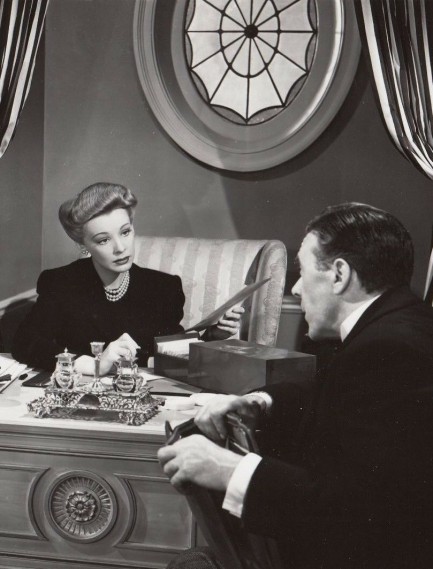 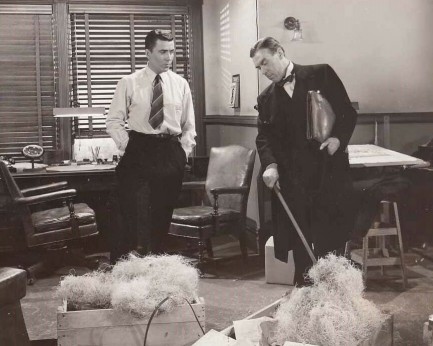 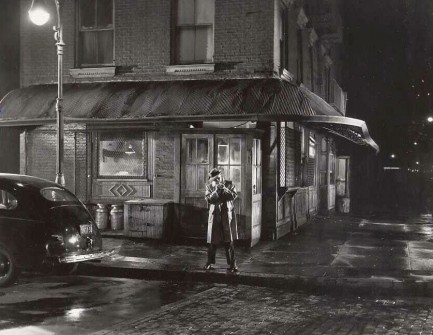 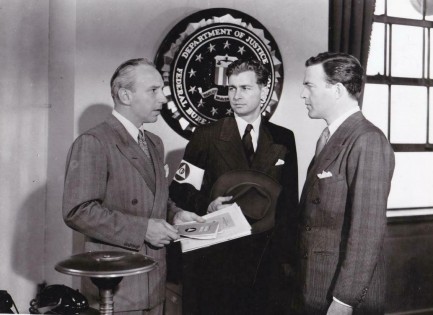 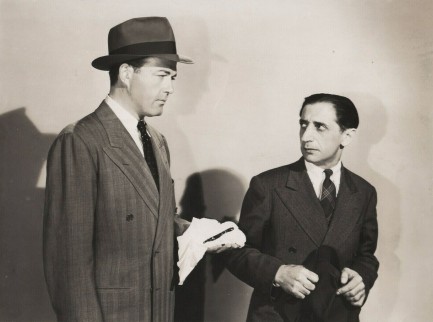 
 These mystical lion statues are supposed to bring good luck and fortune. I'm making this one my agent. 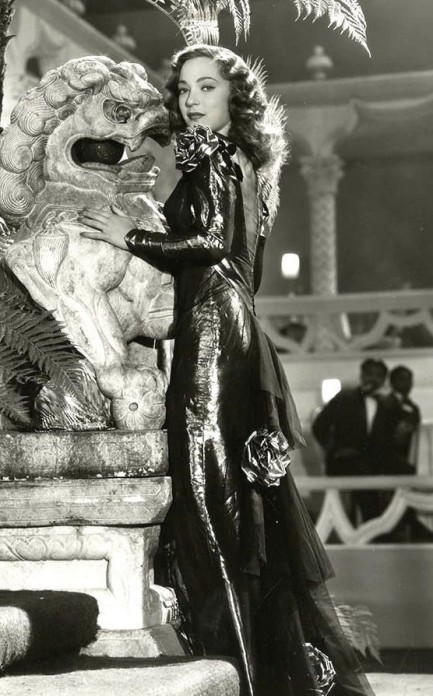
This elegant photo of June Duprez with a Chinese guardian lion was made when she was filming the drama Calcutta. According to tradition these lions ward off malign influences, and no wonder she's hanging onto it. She was born in England during World War I on a night when Germans were bombing her town. She survived and went on to make a mark in Hollywood, appearing in films like The Thief of Baghdad and Little Tokyo, U.S.A., but due to various factors her career stalled, and she found herself broke and cut off from family money back home due to the chaos of World War II. She made it through this second unstable period—no info on whether the lion helped—but her film career never recovered. Even so, we find her to be an impressive screen presence. We've heard that her best movie may be the 1945 mystery And Then There Were None, so we're going to check that out. This photo is from 1946.

|
 |

The headlines that mattered yesteryear.
1945—Mussolini Is Arrested
Italian dictator Benito Mussolini, his mistress Clara Petacci, and fifteen supporters are arrested by Italian partisans in Dongo, Italy while attempting to escape the region in the wake of the collapse of Mussolini's fascist government. The next day, Mussolini and his mistress are both executed, along with most of the members of their group. Their bodies are then trucked to Milan where they are hung upside down on meathooks from the roof of a gas station, then spat upon and stoned until they are unrecognizable. 1933—The Gestapo Is Formed
The Geheime Staatspolizei, aka Gestapo, the official secret police force of Nazi Germany, is established. It begins under the administration of SS leader Heinrich Himmler in his position as Chief of German Police, but by 1939 is administered by the Reichssicherheitshauptamt, or Reich Main Security Office, and is a feared entity in every corner of Germany and beyond. 1937—Guernica Is Bombed
In Spain during the Spanish Civil War, the Basque town of Guernica is bombed by the German Luftwaffe, resulting in widespread destruction and casualties. The Basque government reports 1,654 people killed, while later research suggests far fewer deaths, but regardless, Guernica is viewed as an example of terror bombing and other countries learn that Nazi Germany is committed to that tactic. The bombing also becomes inspiration for Pablo Picasso, resulting in a protest painting that is not only his most famous work, but one the most important pieces of art ever produced. 1939—Batman Debuts
In Detective Comics #27, DC Comics publishes its second major superhero, Batman, who becomes one of the most popular comic book characters of all time, and then a popular camp television series starring Adam West, and lastly a multi-million dollar movie franchise starring Michael Keaton, then George Clooney, and finally Christian Bale. 1953—Crick and Watson Publish DNA Results
British scientists James D Watson and Francis Crick publish an article detailing their discovery of the existence and structure of deoxyribonucleic acid, or DNA, in Nature magazine. Their findings answer one of the oldest and most fundamental questions of biology, that of how living things reproduce themselves.
|

|
|

It's easy. We have an uploader that makes it a snap. Use it to submit your art, text, header, and subhead. Your post can be funny, serious, or anything in between, as long as it's vintage pulp. You'll get a byline and experience the fleeting pride of free authorship. We'll edit your post for typos, but the rest is up to you. Click here to give us your best shot.

|
|










